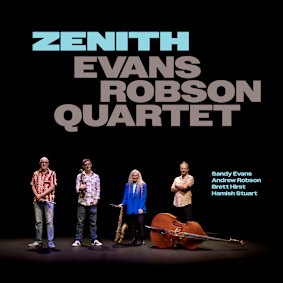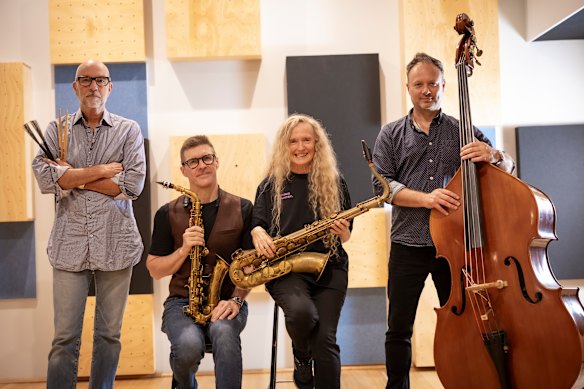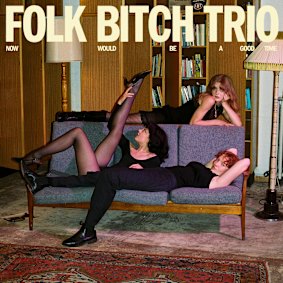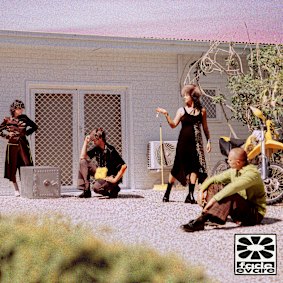By John Shand, Nick Buckley and Robert Moran

Zenith, by the Evans Robson Quartet: a flock in full flight.
Evans Robson Quartet, Zenith
Some people hate pigeons, but in flight a flock can mesmerise with their abrupt turns, take-offs and landings, without ever banging wings. How clumsy we seem, by comparison. Well, not all. Saxophonists Sandy Evans and Andrew Robson, bassist Brett Hirst and drummer Hamish Stuart can curl and twist around each other in musical flight, with a similar capacity to avoid collisions.
This is a key secret of jazz at its highest level: playing around each other, without needing constant points of convergence. The cause is aided in this band by the absence of a chordal instrument, and the consequent expanses of vacant space in the music’s midrange. Watussi Dreaming, for example, is just a bent blues in essence, but give it a polyrhythmic quality and more exotic scalar options, and suddenly, in the hands of these players, it becomes open-ended and unpredictable.
Even more open is Evans’ The Big Merino, which reminds me of something her beloved old band, Clarion Fracture Zone, might have played. Melodically zany, it lurches along over a half-time backbeat that Stuart unwinds behind the solos, so the horns are jerked and twitched like marionettes by the groove. Evans (on tenor) and Robson (baritone) respond with improvisations packed with whacky interval leaps and slurring asides, while Stuart’s subsequent solo is like the soundtrack for a slapstick routine.
Then, to keep the surprises coming, suddenly there’s Robson proving to haunted school children everywhere what an iridescent instrument the descant recorder can be. The piece, his own Tea Horse Road – to these ears as evocative of Native American music as it is of the titular ancient Chinese trade route – rides on Hirst’s bouncy riff and Stuart’s shakers and hand-drumming, and has a skimming solo from Evans’ soprano.
Simpler rhythmic options are also embraced, as on Evans’ slow, soulful tribute to the late Archie Roach, For Archie. Here the bass and drums lay down a straightforward 3/4 groove, across which the saxophones testify like true believers, all preceded by Hirst offering one of his typically supple and heartfelt solos. For Archie also has a cousin in Robson’s lazy-day Lucky Jim, featuring the brawn of his baritone.

The Evans Robson Quartet, featuring drummer Hamish Stuart, saxophonists Andrew Robson and Sandy Evans, and bassist Brett Hirst. Credit: Photography By Grant Leslie
The boppish The Running Tide (by Evans) is reminiscent of Charles Mingus’ work, with its marvellous deployment of accelerations and decelerations. It boasts a seething, bubbling dialogue between the saxophones, before compelling solo statements from both bass and drums.
They end with the aptly titled Cry to the Waning Moon, which reinforces the impression that Hirst’s bass has never been better recorded, with sumptuous low notes and a singing tone higher up. Slow and lonesome, the melody is taken by Robson’s alto and harmonised by Evans’ tenor. This could well become my favourite composition on an album packed with strong ones from both leaders and with a wealth of slippery dialogues between four master musical conversationalists. John Shand

Now Would Be a Good Time, by Folk Bitch Trio: join their inner circle.
Folk Bitch Trio, Now Would Be a Good Time
Folk Bitch Trio’s harmonies have the psychoacoustic effect of feeling as though you’re tapping the near-telepathic lines of imperceptible communication shared by old friends. Heide Peverelle, Jeanie Pilkington and Gracie Sinclair have been friends since high school and their debut album, Now Would Be a Good Time (out July 25), brings the listener into their communion. But it does so without the members losing their individuality. The song’s details are hyper-specific and clearly born from individual experience.
Now Would Be a Good Time’s textured analogue recording – made in Aotearoa/New Zealand with Marlon Williams collaborator, Tom Healy – takes folk music’s requisite guitar and vocal arrangements, but transcends the genre’s often uncomfortable earnestness. It’s funny, a bit horny, and still deeply confessional. Take the tragicomic chorus of The Actor: “What could I say to make this right? Afternoon f--- and then a fight. When everybody’s listening. My friends are in the kitchen.”
The members began by writing on their own, before bringing their work to the group. The tactic has produced a set of songs that feel like stories being shared from one friend to another, deep into the night. For 10 exquisite tracks, you get to join that inner circle. Nick Buckley

Welcome Back, by Fade Evare: spaced out sibling revelry.
Fade Evare, Welcome Back
Here’s the ideal I’d base my dictatorship on: all siblings should be forced to sing together. I don’t understand the science, but intrafamilial voices entwining like double helixes is a magic that runs through pop since time immemorial. Enter Fade Evare.
The Melbourne trio – made up of sister-and-brother pairing Mira and Tori Holleman, and keyboardist Madeleine Magee Carr – make atmospheric electro-pop so alchemically aligned, they’re like the Carpenters if the Carpenters had been raised on the XX and wonky IDM.
On their debut album Welcome Back (out July 11), subtlety is their strength. Opener Anymore builds with a sparse beat and guitar strums that recall the off-kilter atmospherics of Mk.gee, while Mira’s melodic vocals pluck out an understated earworm. Send Me Out turns a muted electro squiggle into an addictive groove, before the sibling harmonies pierce like light through fog.
The effervescent highlight is Sky Writing, which pairs a boom-bap beat with the kind of jangling guitars that would make Bernard Sumner smile. And again, those swirling sibling harmonies that send the track soaring till it dissipates like chemtrails. It’ll make you pity the only child.
To read more from Spectrum, visit our page here.